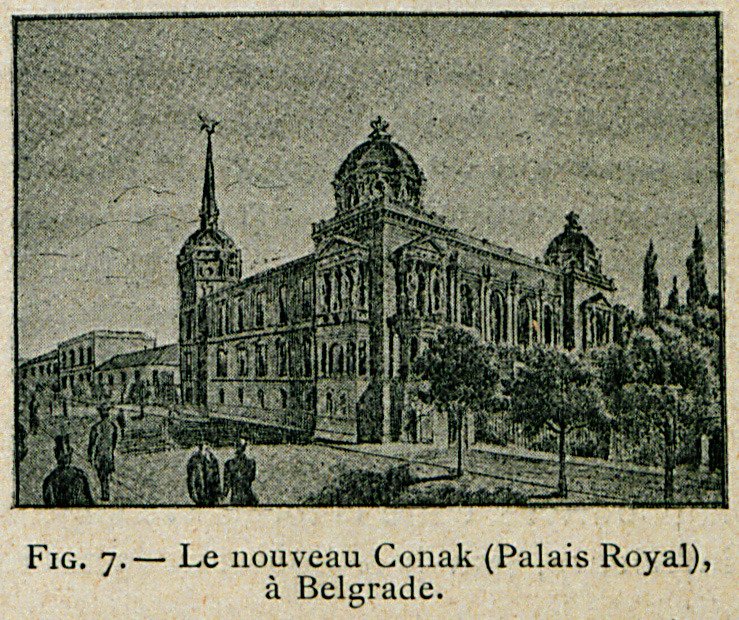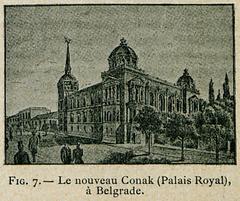
Royal Palace Belgrade: Visiting Hours, Tickets, and In-Depth Travel Guide
Date: 14/06/2025
Introduction
The Royal Palace in Belgrade is a premier historical and cultural landmark, embodying the royal legacy, architectural splendor, and national identity of Serbia. Situated in the prestigious Dedinje district, this compound, commissioned by King Alexander I and constructed between 1924 and 1929, exemplifies Serbian-Byzantine Revival style and stands as the principal residence of the Karađorđević dynasty. Visitors are invited to immerse themselves in a living monument that continues to connect Serbia’s past with its present, offering insightful guided tours, access to period interiors, and breathtaking gardens.
This comprehensive guide provides everything you need to plan your visit: detailed history, architectural highlights, ticketing information, tour schedules, accessibility, and travel tips. For the most up-to-date information, always consult official resources or consider digital audio guide apps like Audiala for an enhanced experience (stillinbelgrade.com; Tourist Organization of Belgrade; royalfamily.org).
Table of Contents
- Introduction
- Historical Development of the Royal Compound
- Architectural Significance and Key Structures
- Cultural and National Importance
- Visitor Information: Hours, Tickets, and Tours
- Getting There and Accessibility
- Tour Experience and Highlights
- Visitor Guidelines and Practical Tips
- Frequently Asked Questions (FAQ)
- Conclusion
- References
Historical Development of the Royal Compound
Origins and Royal Patronage
Commissioned by King Alexander I and built using his private funds, the Royal Palace was intended as a tangible symbol of the Karađorđević dynasty’s aspirations for a modern yet tradition-rooted Serbia. Completed in 1929, it became the home of King Alexander I, and later his son King Peter II. The vision extended beyond personal residence; it was to be a visible manifestation of the monarchy’s stability and national pride (stillinbelgrade.com).
The White Palace and Expansion
Following King Alexander I’s assassination, the complex was expanded to include the White Palace (Beli Dvor), constructed between 1934 and 1937 for his sons. Designed in classicist style by Aleksandar Djordjević, it became the residence of Prince Regent Paul and his family. Over time, the compound’s role evolved, reflecting the political and cultural shifts of Yugoslavia and later Serbia (Wikipedia).
Architectural Significance and Key Structures
The Royal Palace (Kraljevski Dvor)
The Royal Palace is a masterpiece of Serbian-Byzantine Revival architecture, designed by Živojin Nikolić and Nikolay Krassnoff. Notable features include:
- White stone façade and colonnades
- Arched terraces with panoramic city views
- Interiors adorned with frescoes inspired by medieval Serbian monasteries
- Blue Drawing Room (Baroque style), Gold Drawing Room and Dining Room (Renaissance style)
- Basement modeled after the Terem Palace in Moscow, with a cinema and wine cellar (Lonely Planet)
The White Palace (Beli Dvor)
Distinct from the Royal Palace, the White Palace is designed in French classicist style, with interiors furnished in Louis XV and XVI styles, Venetian chandeliers, and one of the country’s largest private libraries. The building was used by royal family members and later by Yugoslav leaders for state occasions (Never Ending Footsteps).
The Royal Chapel of St. Andrew the First-Called
Attached to the south side of the Royal Palace, the chapel is modeled after the medieval Church of St. Andrew in Macedonia. The interior is richly decorated with frescoes by Russian émigré artists, reinforcing the spiritual and dynastic continuity of the Karađorđević family (Serbia Incoming).
The Thatched House (Slamnata Kuća)
Originally the residence of King Alexander I during the palace’s construction, this building later served as an art studio and is now used by Prince Philip and his family (Wikipedia).
Gardens and Parklands
Designed by Eduard André, the gardens combine French geometric and English landscape traditions, offering terraces, pergolas, pavilions, and sweeping views of Belgrade, Koshutnjak Forest, and Avala Mountain (serbia.com).
Cultural and National Importance
The Royal Compound is a living symbol of Serbian statehood, national memory, and cultural preservation. As a repository of art and host to official and charitable events, it continues to play a vital role in public life. The palaces and chapel represent not only architectural beauty but also the historical resilience and evolving identity of Serbia through monarchic, socialist, and contemporary eras (stillinbelgrade.com).
Visitor Information: Hours, Tickets, and Tours
Visiting Hours
- Season: April to October (public access is limited to these months)
- Standard Tour Times (June 2025): Saturdays at 9:30 am (Serbian) and 12:30 pm (English)
- Duration: 1.5–2 hours
- Days Open: Tours typically run on weekends and selected weekdays. The palace is closed on Mondays and public holidays.
Tickets and Booking
- Current Ticket Price: 1,500 RSD (approx. €13), grants access to the Royal Palace, White Palace, and chapel (Tourist Organization of Belgrade)
- Booking: Reservations are mandatory due to limited group sizes (30–35 people). Book at the Tourist Information Centre, by phone (+381 11 26 35 622), or by email ([email protected]).
- Discounts: Available for students, seniors, and groups; inquire when booking.
- Payment: Usually at the Tourist Information Centre or upon arrival.
Accessibility
- Mobility: Most of the compound is accessible; some historical areas may be challenging. Contact organizers for specific needs.
- Facilities: On-site restrooms; no cafés inside the compound.
Photography Policy
- Outdoors: Permitted in gardens and exterior areas.
- Indoors: Restricted in palace and chapel interiors to preserve artworks. Always follow guide instructions.
Getting There and Accessibility
- Address: Bulevar kneza Aleksandra Karađorđevića 96, Dedinje, Belgrade
- By Bus: Line E9 from Republic Square, transfer to line 42 at Franše D’Eperea
- By Taxi/Car: 15–20 minutes from downtown; paid parking available on site
- Walking Tips: The compound is on a hill; wear comfortable shoes
Tour Experience and Highlights
What to Expect
Guided tours offer access to:
- Royal Palace Ceremonial Halls and Private Cinema
- White Palace’s Grand Hall, Library, and Drawing Rooms
- Royal Chapel with Iconic Frescoes
- Gardens and Terraces with City Views
Special features include the Room of Whispers (a sound-muffling chamber), centuries-old art collections, and, on occasion, the chance to meet members of the royal family (Royal Central).
Visitor Guidelines and Practical Tips
- Dress Code: Modest attire is required, especially within the chapel.
- Group Size: Tours are limited to preserve interiors.
- Languages: Tours in Serbian and English; other languages on request.
- Children: Family-friendly, but stroller access may be limited.
- Accessibility: Contact ahead for mobility assistance.
Frequently Asked Questions (FAQ)
Q: How do I book Royal Palace tickets?
A: Book at the Tourist Information Centre, online, by phone, or email. Advance reservation is recommended.
Q: What are the Royal Palace visiting hours?
A: April–October; tours on weekends and select weekdays. Check the official Tourist Organization of Belgrade for current times.
Q: Is the site accessible for visitors with disabilities?
A: Most key areas are accessible; contact organizers for specific requirements.
Q: Can I take photos inside?
A: Outdoor photography is allowed; indoor photography is restricted.
Q: Are guided tours available in English?
A: Yes, and in other languages upon prior arrangement.
Conclusion
A visit to the Royal Palace and Dedinje Royal Compound is an immersive journey through Serbian royal history, art, and architectural achievement. With well-organized guided tours, accessible facilities, and a wealth of cultural treasures, the compound offers an enriching experience for all visitors. Plan ahead by booking tickets, checking the latest tour schedules, and preparing for an inspiring exploration of Belgrade’s royal heritage. Enhance your visit with digital audio guides like Audiala and stay informed by following official websites for updates.








































































